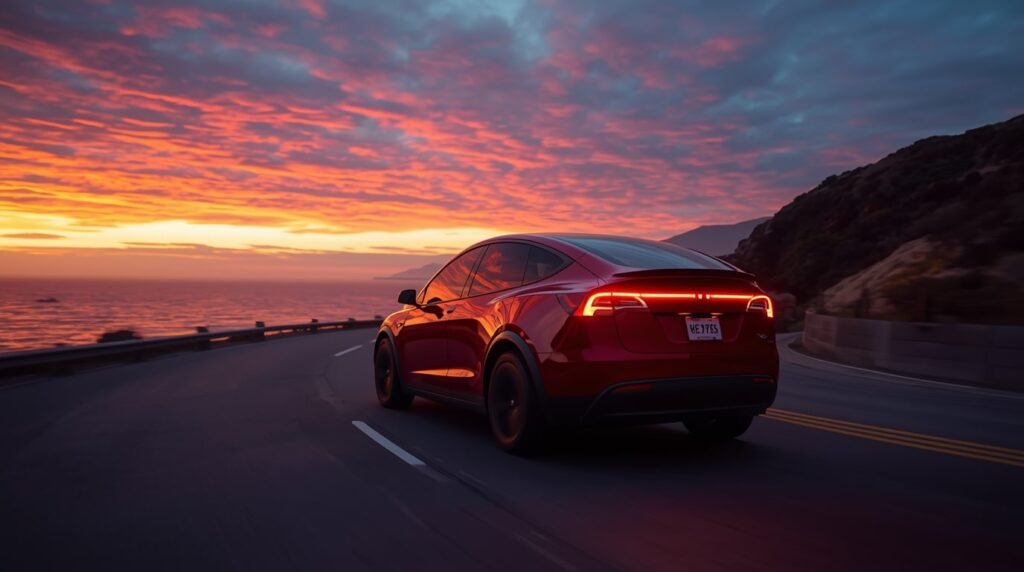
Still in the electricity core of the automotive revolution, the 2025 Tesla Model Y remains the unquestioned EV leader by combining futuristic innovation with affordable mass-market popularity. It is a midsize SUV updated under the code name Juniper, and it has gone on to become the global best-selling electric car, even surpassing gas-powered classics like the Toyota Corolla.
The secret of the Model Y lies in a smooth combination of performance, practicality, and sustainability, selling more than 150,000 units in the first half of 2025 alone—though with a slight drop compared to last year due to broader market changes.

2025 Updates & Styling
The update includes Cybertruck-inspired styling with a full-width light bar and lower front splitter, improving aerodynamics. Inside, the minimalist cabin features a 15.4-inch centre touchscreen, an 8-inch rear passenger display, and power-reclining seats that fold to reveal 2,130+ litres of cargo space.
Powered by an advanced 81 kWh battery, the Model Y supports 250 kW DC fast charging, adding 150–200 miles in just 15 minutes.
EV Leader Position: Why the Model Y Rules
With over 40% U.S. EV market share in 2025 and 146,000 units sold in the first half, the Model Y outpaces rivals like the Ford Mustang Mach-E and Hyundai Ioniq 5. Tesla’s vertical integration—from batteries to software—drives this dominance.
It seats up to seven, fits within a compact 4.79m footprint, and starts at just $44,990 (RWD), eligible for up to $7,500 in federal tax credits. The Performance AWD tops out at $51,490. Owners save an estimated $5,750 in fuel over five years, with electricity costs averaging $1.01 per 25 miles.
Safety is another advantage—5-star ratings from NHTSA and Euro NCAP, standard Autopilot, and crash data showing one accident every 6.69 million miles (10x safer than the U.S. average).
| Variant | Starting Price | EPA Range | 0-60 mph | Key Leadership Edge |
|---|---|---|---|---|
| RWD | $44,990 | 337 miles | 5.4 sec | Most efficient entry, WLTP 22.36 kWh/100 miles |
| Long Range AWD | $47,990 | 311 miles | 4.6 sec | All-weather traction and balanced power |
| Performance AWD | $51,490 | 277 miles | 3.5 sec | Supercar acceleration with daily usefulness |
Epic Range: Everyday & Long Trips
Range anxiety? Not here. The RWD trim reaches up to 337 miles, surpassing competitors like the Hyundai Ioniq 5 (318) and Ford Mustang Mach-E (320). AWD trims deliver 277–311 miles, with real-world efficiency of 3.5–4 mi/kWh.
Juniper improvements—better aerodynamics and low-rolling-resistance tyres—boost range by up to 10% compared to 2023 models. Even in cold weather, owners see 250–280 miles.
Charging: 250 kW Superchargers restore 10–80% in 27 minutes (or ~150 miles in 15). Level 2 home charging adds 44 miles/hour, with smart preconditioning for max efficiency.
Supercharger Network: Tesla’s Backbone
With over 70,000 global Superchargers (15,000+ in North America), Tesla leads charging reliability (99.95% uptime). V4 hardware in 2025 will support 500 kW charging, on-stall payments, and longer cables.
The adoption of the North American Charging Standard (NACS) ensures seamless plug-and-charge simplicity. Charging costs average $0.30–0.50/kWh—cheaper than most rivals.
Game-Changing Features: Juniper Refresh
The 2025 update brings a Cybertruck-inspired fascia, full-width LEDs, and 20-inch wheels. Ride quality improves with retuned suspension and adaptive dampers.
Inside: stalkless steering yoke, ventilated seats, ambient lighting, and OTA-powered infotainment on a 15.4-inch screen. Rear passengers enjoy an 8-inch climate/entertainment display. Enhanced Autopilot includes automatic lane changes, with unsupervised Full Self-Driving teased for late 2025.
Efficiency upgrades include a smarter heat pump and improved one-pedal driving, adding 5–7% energy gains. Over-the-air updates keep the car fresh with new features like Sentry Mode upgrades and energy-saving modes.
The Future Tesla Model Y
The Tesla Model Y remains the giant of EVs, redefining road trips with its range, Supercharger dominance, and constant innovation. It is not simply keeping up in the race to go green—it is leading, mile by mile, into a future of zero emissions and limitless possibilities.

